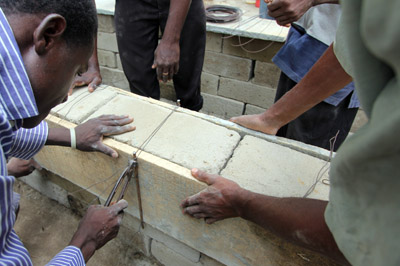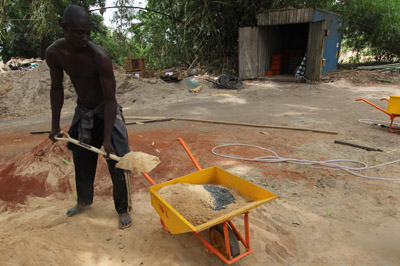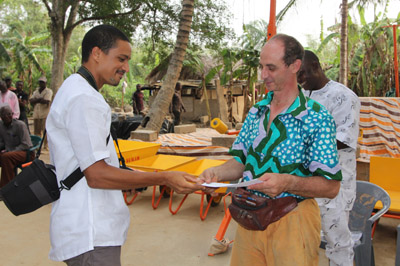Technology transfer
Nigeria, April 2011
- Technology Transfer – Haiti, August 2011
- Technology Transfer – Nigeria, April 2011
- Technology Transfer – Egypt, January 2011
- Tanzania, Winter 2009
- Spiti August, 2009
- Kathmandu, August 2009
- Tanzania, July 2009
- Jantanagar School, September 2008
- Spiti, August 2008
- Nepal, June 2008
- Technology Transfer: AKAH, Syria, July 2020
Mr. Satprem Maïni, Director of the Auroville Earth Institute (AVEI) has been invited by the Chife Foundation (CF) to conduct a technology transfer for the production of CSEB and building the Anam New City with the technologies developed by the Auroville Earth Institute. The first step of this technology transfer is a training course on CSEB production and defining the mix specifications for the particular clayey soils of Anam. This programme happened between the 28th of March and the 12th of April 2011.
Anam New City is a new sustainable development in Anambra State, Nigeria initiated by the Dr. Aloy & Gesare Chife Foundation in partnership with the greater Anam community. The project is envisioned for a Phase 1 population of 1000 in one to two years, with expansion to over 100,000 in subsequent decades. Anam New City is a dynamic model for sustainable development that balances ecology with economic growth, delivers world-class quality of life across generations and leverages technology within the African culture of collective progress.
Anam is simultaneously a model city and a new model for sustainable development in Africa. It is a project that fundamentally reorganizes society in order to bring about real and lasting change. It is an alternative paradigm — variably referred to as agropolitan or rurban in development planning circles — that combines the benefits of modern urban living with those of rural communities and traditional productive landscapes. It is, at its core, an initiative to generate local economic opportunity, but it is equally a strategy for using technology – within an integrated logics framework for conceptualizing the African city – to improve people’s lives.
Toward this end, the Chife Foundation intends to utilize locally-available silt-clay and sand deposits to produce Compressed Stabilized Soil Blocks (CSEB) locally. Labour-intensive and low-energy production processes are preferred, in order to maximize job production and minimize energy demand. See more information on the project at http://anamcity.com/
SOIL ANALYSIS
The locally available soils from Anam New city are normally not suitable for producing CSEB, according to normal standards and procedures. Their clay and silt content varies from 65 to 80% and the clay alone is not less than 40 %. Therefore these proportions are far too high for this kind of a technique. Only a few veins of silty soils were found along the river Izuchi. But these deposits were so irregular that these soil qualities proved to be impossible to use, as clay layers were mixed quickly and changed the soil quality drastically. Lateritic soils are available in Otuocha area. These are good soils but expensive and they have to be transported from far away.
Clayey soils can be used for CSEB production if their proportions of clay and silt do not exceed 50% and they need to be stabilised with lime instead of cement. Lime stabilisation has been rejected because of its price (four times the price per kilo of cement). Such soils need to be amended with a lot of sand and fine aggregates which can be mixed by hand after sieving the soil.
But the soils from the site of Anam New City are too plastic to be used for the production of CSEB. Their plasticity and cohesion are too high. They don’t have a proper structure, as they lack coarse particles, and their compressibility is very low. Soils with such amounts of clay and silt need to be totally dried and then pulverised with specialised and heavy machinery. But the weather of Anam area is such that there are regular rains all along the year with about 2000 mm per year. The clay deposit, being along the river, is also always humid because of the capillary from the river. Therefore, the ground is hardly dry.
Therefore, a totally different process has been envisaged for the soil preparation, which is to dilute clay in water and mix the slurry with sand, granite dust and cement. Thus, this mixture recomposes a new soil. But the difficulty with this system is to control the fluidity of the slurry in such a way that the slurry does not add too much water to the mix and adds enough clay to the sand-granite dust ratio.
Four days were spent at the site to analyse the samples collected. These analysis consisted of: Sensitive analysis to determine the main properties of the soil, grain size distribution by sedimentation to know the percentage and size of the finest particles, shrinkage test to determine linear shrinkage and methylene blue test to find out the clay type. Six samples were analysed:
|
ELABORATION OF MIXES
1. Laboratory tests
Three clay slurries of various proportions of clay and water were tried in small quantities order to define a proper ratio to be added to the sand-granite dust mix.
In most cases the mix was too wet to be compressed and had a low to medium plasticity and cohesion. One of the problems of these tests was the small quantities used for the mix. Therefore these tests were not representative enough of the reality and it was preferred to try real sizes which could be compressed in the press.
2. Preparation of tanks for mixing the clay paste
Preparing the clay slurry required tanks, where the clay should be mixed and kept to rest at least one day.
Therefore, 4 tanks were built with the means available on site in between both platforms for block making (2 per press).






3. Practical tests for the clay paste
Five different clay pastes were tried simultaneously with the mix for block making.
The aim of these tests was to have the optimal fluidity of the clay-water ratio so that the mix for block making was not too wet and had enough clay to bind the aggregates. Finally, the mix was not a clay slurry anymore but a clay paste. It was extremely difficult and labour intensive to mix it. Therefore, we made some tools to ease the process.
First, we made a hand tool to mix the slurry and it was working well as long as the mix was still fluid. But when the paste got thicker, it was too hard to pull. Therefore, we tried to manufacture a mixing machine but several problems were encountered:
- First the motor was too weak (750 W) as it was the only model available at that time.
- Then we found a 5 HP motor which was stirring the paste at the beginning. But progressively the motor slowed down and stopped when the propeller went to the bottom of the tank.
- It seemed that the propeller had too many blades and we cut half of them.
- But finally, the welding of the shaft broke two times as it was not done well &the machine could not be used.



Therefore, the prototype of the mixer machine which was manufactured should be developed in order to ease the process. But in fact a better system for mixing the clay paste would be to buy a rotary tiller also called “Roto Tiller”. This machine should be equipped with blades and not discs, in order to churn the clay properly.
4. Practical tests with the press for block making mixes
Fifteen mixes for block making were tried with various results: Some of them did not work at all and some of them gave poor results. For most of them, the mix was again too wet, as the slurry was too liquid and often the mix lacked cohesion. The aim of these tests was to get the optimum compressibility and cohesion so that they could be compressed to a maximum and handled properly.
SPECIFICATIONS of FINAL MIXES
1. Final clay paste
After many trials the following mix appeared to be the best.
Ratio
- Water = 900 litres
- Clay = 2,100 litres
Note that clay should be as dry as possible, as it is difficult to adjust the proper moisture content of the paste. Therefore, to avoid such problems it is better to fill only 800 litres in the tank and then pour clay. The viscosity should be tested according to the procedure described hereafter and if it is too thick, then extra water should be added progressively. This ratio will give about 2,000 litres of clay paste which should be enough for one day production of 850 blocks per press. If, in case, this paste is not enough for one day production, the ratio above should be increased proportionally.










11. Extra water may be added to get the proper viscosity of the paste if the rod does not go 30 cm inside.
12. If the rod penetrates a little more at the end of churning, it will be OK the next day, as clay will still absorb water in the following day.

13. This paste should rest in the tank for one day before being used. It can stay longer but it should be covered with a plastic sheet in order to avoid evaporation. Viscosity should be checked again before using and extra water may be added.
2. Final mix for block making
The final mix was the Ref. O. It gave the best results for the cohesiveness and the compressibility. Moisture content was fine, but it was still a sandy mix. The result with the penetrometre was the best.
This mix can be used for the block making:
Ratio
| Gravel 1/4” | = 17 Litres | = 1 bucket |
| Coarse Sand | = 58 Litres | = 1 wheelbarrow 75 litres – 1 bucket 17 litres |
| Fine silty sand | = 58 Litres | = 1 wheelbarrow 75 litres – 1 bucket 17 litres |
| Clay paste | = 68 Litres | = 4 buckets 17 litres |
| Cement | = 1/4 bag (12.5 Kg) | = 1 bucket 13.5 litres (1 bag divided in 4 buckets) |
Note that it is essential that gravel, coarse sand and fine silty sand should be as dry as possible. If they are humid, the mix will become too wet and it will not be compressible. Therefore, it will be necessary to leave the piles under the sun to dry and to cover them at night if there is any risk of rain. On the opposite, sometimes water should be added to the mix before adding the clay paste.
Percentages
This mix gives a cement ratio of 4.65 % by weight and the proportions of the recomposed soil are:
Gravel 1/4” = ~ 10 % – Sand = ~ 60 % – Silt = ~ 15 % – Clay = ~ 15 %












13. Mix is ready to be compressed when there are no lumps bigger than 1/2”
TRAINING COURSE
1. Theoretical course



2. Practical course






BLOCK MAKING PROCESS









CELEBRATION WITH THE ELDERS OF THE COMMUNITY AND THE TEAM OF THE CHIFE FOUNDATION












Contact US
- Address:Auroville Earth Institute, Auroshilpam, Auroville 605 101 - T.N. India
- Phone:+91 (0) 413 - 262 3330 / 262 3064
- Email:info@earth-auroville.comOpens in your application



